Sensitive quantification of phosphatidylethanol (PEth) as a marker of chronic alcohol use in dried blood spots (DBS)
Using SWATH data independent acquisition (DIA) on the SCIEX X500R QTOF system
Marta Massano1,2 , Christina Ververi1, 2 , Daniele Di Corcia1 , Marco Vincenti1,2 , Alberto Salomone1,2 and Pierre Negri3
1Centro Regionale Antidoping e di Tossicologia “A. Bertinaria”, Italy; 2Università degli Studi di Torino, Turin, Italy; 3SCIEX, USA
Abstract
In this technical note, an optimized sample extraction procedure was combined with an accurate and sensitive quantification method for detecting phosphatidylethanol (PEth) extracted from dried blood spots (DBS). The presented workflow provides the ability to accurately quantify relevant levels of PEth extracted from DBS, therefore providing a sensitive and reliable marker of chronic alcohol consumption.
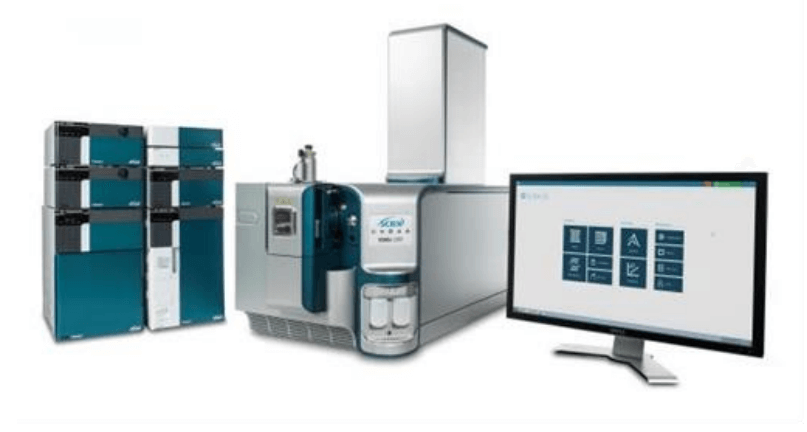
Introduction
The prevalence of long-term alcohol abuse and dependence burdens society worldwide. These disorders are associated with a wide range of diseases and injuries that can affect many sociodemographic groups, potentially resulting in significant risks and costs. As a result, an accurate assessment of chronic alcohol consumption is needed in treatment and research.
There has been increasing interest in using direct metabolites of ethanol as accurate biomarkers of chronic alcohol consumption. One of the most specific biomarkers associated with chronic alcohol use is PEth, which is a group of phospholipids that forms in the cell membrane of red blood cells in the presence of ethanol.1 Accurate quantification of PEth in whole blood provides the best evidence of long-term alcohol use but this approach is limited by time-consuming and labor-intensive sample preparation procedures. Recently, DBS have been used to significantly simplify and shorten sample preparation. Compared to traditional venous blood sampling, DBS benefits from a minimally invasive finger-prick method for the collection of a small sample volume, increased analyte stability, overall longterm stability and lack of sample transport and storage requirements. These features of DBS sample collection and analysis facilitate remote testing.
Figure 1. SWATH DIA enables sensitive quantification of PEth extracted from DBS. XIC traces of the calibration series for PEth from 20 to 500 ng/mL. The use of SWATH DIA on the SCIEX X500R QTOF system enabled sensitive quantification of PEth from DBS.
Key features of the SWATH DIA method for the accurate quantification of PEth in DBS
- The optimized sample extraction procedure and robust detection method using SWATH DIA enabled selective and sensitive detection of PEth in DBS (Figure 1)
- The method was highly sensitive, as limits of detection (LOD) and quantification (LOQ) of 5 ng/mL and 10 ng/mL, respectively, were observed for PEth extracted from DBS
- Accuracy and precision were maintained across the calibration range tested (20 to 500 ng/mL)
- Excellent linearity with statistically significant linear regression t and f tests, and p-value <0.05 for PEth with optimal precision (<20%) and accuracy (bias ±20%) across the calibration range
- The matrix effect ranged between -2.7% and -14% and the extraction efficiency was higher than 30%
- The method permitted robust and reliable quantification of PEth, allowing assessment of long-term alcohol consumption
Experimental details
Target analytes and calibrator preparation: PEth 16:0/18:1 and PEth 16:0/18:1-D5 were purchased from Millipore Sigma (Saint Louis, MO). Five levels of calibrators were prepared by spiking PEth into human whole blood to final concentrations ranging from 20 to 500 ng/mL.
Sample preparation and DBS sample extraction procedures: DBS cards were purchased from Whatman (Piscataway, NJ). Human whole blood calibrator samples spiked with various concentrations of PEth were spotted on the DBS cards. The sample extraction procedure summarized in Figure 2.
Figure 2. PEth extraction workflow from DBS cards. A 12-step sample extraction protocol was optimized to selectively extract PEth from DBS cards for analysis using the SCIEX X500R QTOF system.
Liquid chromatography: UHPLC separation was performed using the SCIEX ExionLC AC system and an ACQUITY UPLC BEH HILIC column (100 x 2.1 mm, 1.7 µm) held at 45ºC. Mobile phase A was 0.1% formic acid in water with 10 mM ammonium formate, and mobile phase B was acetonitrile. The LC flow rate was 0.5 mL/min and the total run time was 10 min. The injection volume was 5 µL.
Mass spectrometry: MS and MS/MS data were collected for each sample using SWATH DIA on the SCIEX X500R QTOF system in positive ionization mode. Data acquisition included a TOF MS scan (124-793 Da) followed by a TOF MS/MS experiment to monitor the most abundant fragment ions in the mass range from 60 to 707 Da using 13 SWATH DIA Q1 windows. Data were acquired using SCIEX OS software, version 2.0.1. Samples were injected in triplicate over the course of 3 consecutive days to build a data processing method.
Data analysis: Data were processed using SCIEX OS software, version 2.0.1.
SWATH DIA enables sensitive quantification of PEth extracted from DBS
Blank human whole blood samples were spiked with each of the prepared calibrators. A volume of 30 µL of each calibrator solution was spotted onto a DBS card. PEth was extracted from the DBS cards using the procedure described in Figure 2 and injected to build a data processing method. Detection and integration of the peaks from the background were accomplished using the MQ4 algorithm in the Analytics module of SCIEX OS software. Analysis of these samples was used to verify the following validation parameters: linearity, inter- and intra-day accuracy and precision, LOD and LOQ.
Figure 1 shows extracted ion chromatograms (XICs) of PEth at each of the 5 concentrations tested in the calibration range (20 to 500 ng/mL). A calibration curve was generated to determine the linearity of the assay across the calibration range. Figure 3 shows the resulting regression line for PEth from 20 to 500 ng/mL, which shows that the assay demonstrated excellent linearity with an R2 value of 0.998.
Figure 3. SWATH DIA enables sensitive quantification of PEth extracted from DBS. Calibration curve resulting from the calibration series for PEth from 20 to 500 ng/mL. The calibration curve demonstratre excellent linearity with an R2 value of 0.998.
Inter-day and intra-day precision (expressed as percent variation coefficient, CV%) and accuracy (expressed as bias%) were below 20%. Figure 4A shows XICs of the 50 ng/mL calibrator extract from 3 consecutive days of sample injections. Figure 4B shows the XIC areas plotted as a function of injection number. The red line represents the theoretical area for a 50 ng/mL calibrator extract. The %CV for these 10 measurements was 6.2%. The results show high measurement accuracy and precision for the 9 consecutive injections, demonstrating the robustness of the presented workflow.
Last, LOD and LOQ in the matrix were tested with independent experiments on spiked samples at three concentrations to verify that the signal-to-noise was >3. The results showed that at 5 ng/mL the S/N raio was >10, resulting in an LOD and LOQ of 5 ng/mL and 10 ng/mL, respectiviely. The results demonstrated that in addition to being sensitive, the workflow enabled the precise and accurate detection of PEth from DBS.
Optimized sample preparation procedure leads to low ion suppression and acceptable extraction efficiency
Achieving reliable quantification in DBS analysis requires optimization of the extraction method based on the physical and chemical properties of the target analyte. Here, the current sample preparation procedure was optimized to selectively extract PEth from DBS. The efficiency of the sample preparation procedure to selectively remove the matrix interferences was determined by calculating the matrix effect, which is defined as the ion suppression/enhancement ratio and is expressed as ±%. The matrix effect was calculated at the 20 ng/mL calibrator level by expressing the ratio of the peak area of each analyte in neat solvent vs. post-extraction spiked matrix as a percentage. Moderate ion suppression was observed, with final values ranging between -2.7% and -14%.
Figure 4. Robust SWATH DIA acquisition method leads to precise and accurate quantification of PEth from DBS. A) XIC traces resulting from 9 sample injections performed over the course of 3 consecutive days (3 injections each day x 3 days = 9 total injections) of the 50 ng/mL calibrator extract. B) Plot of the XIC areas as a function of injection number. The red line shows the theoretical area for a 50 ng/mL calibrator extract. The %CV for the 9 measurements was 6.2%. The results demonstrate that SWATH DIA generates excellent measurement accuracy and precision.
The analyte recovery of the 500 ng/mL calibrator level was calculated by expressing the ratio of the peak area of PEth before and after the extraction procedure as a percentage. The method showed an extraction efficiency higher than 30%. Although not high, the analyte recovery is acceptable, given the high reproducibility of the assay, the achieved LOD and LOQ values and the ability to accurately quantify various levels of PEth extracted from DBS with high precision and accuracy. In this scenario, the use of deuterated internal standards is recommended to compensate for the loss of analyte.
Conclusion
A comprehensive workflow for the quantification of PEth extracted from DBS was successfully developed using the SCIEX X500R QTOF system. The combination of a rapid and optimized sample extraction procedure and robust MS/MS method using SWATH DIA enabled selective, sensitive and accurate quantification of PEth as a chronic alcohol consumption biomarker. The method showed excellent sensitivity, with an LOD of 5 ng/mL and a LOQ of 10 ng/mL for PEth extracted from DBS. Inter-day and intra-day precision and accuracy (expressed as %CV and bias%, respectively) were below 20%, indicating that PEth quantification from DBS was both precise and accurate across the calibration range tested. Excellent linearity was observed with stasticallly significant linear regression t and f tests, and p-vaue <0.05 for PEth across the calibrator series that ranged from 20 to 500 ng/mL. The matrix effect ranged from - 2.7% to -14% and the extraction efficiency was higher than 30%, demonstrating the efficiency of the sample extraction method for selectively extracting PEth from DBS. Overall, the method provided a robust means to monitor long-term alcohol consumption with high accuracy and precision.
References
- Nguyen, V. L., Paull, P., Haber, P. S., Chitty, K., & Seth, D. (2018). "Evaluation of a novel method for the analysis of alcohol biomarkers: Ethyl glucuronide, ethyl sulfate and phosphatidylethanol." Alcohol 67: 7-13.
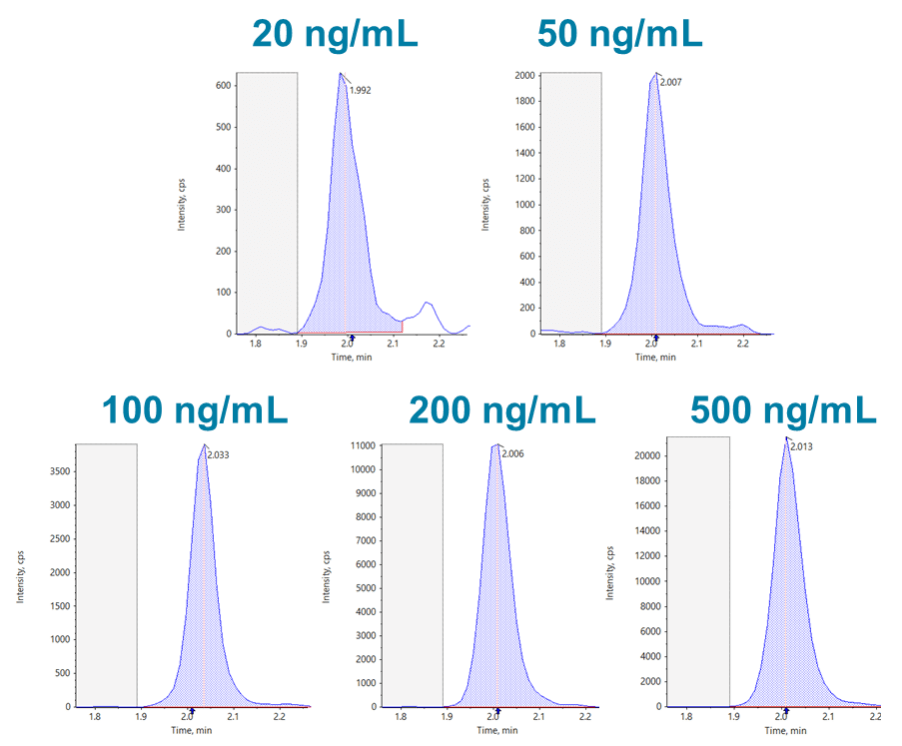 Click to enlarge
Click to enlarge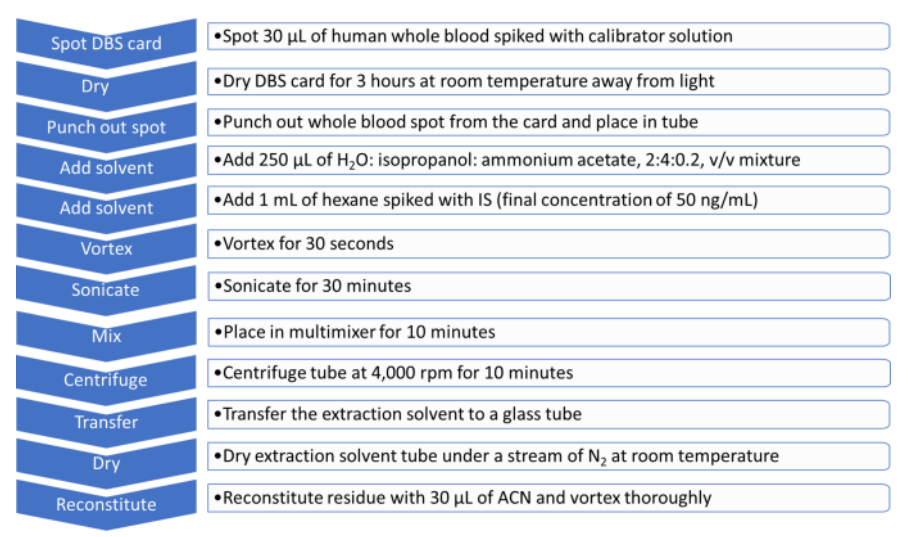 Click to enlarge
Click to enlarge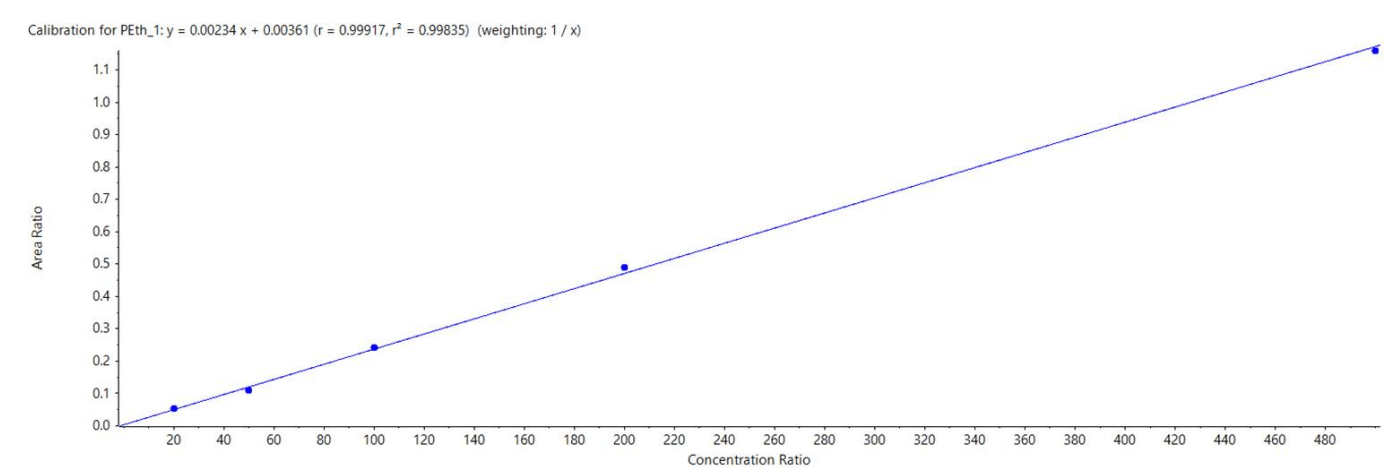 Click to enlarge
Click to enlarge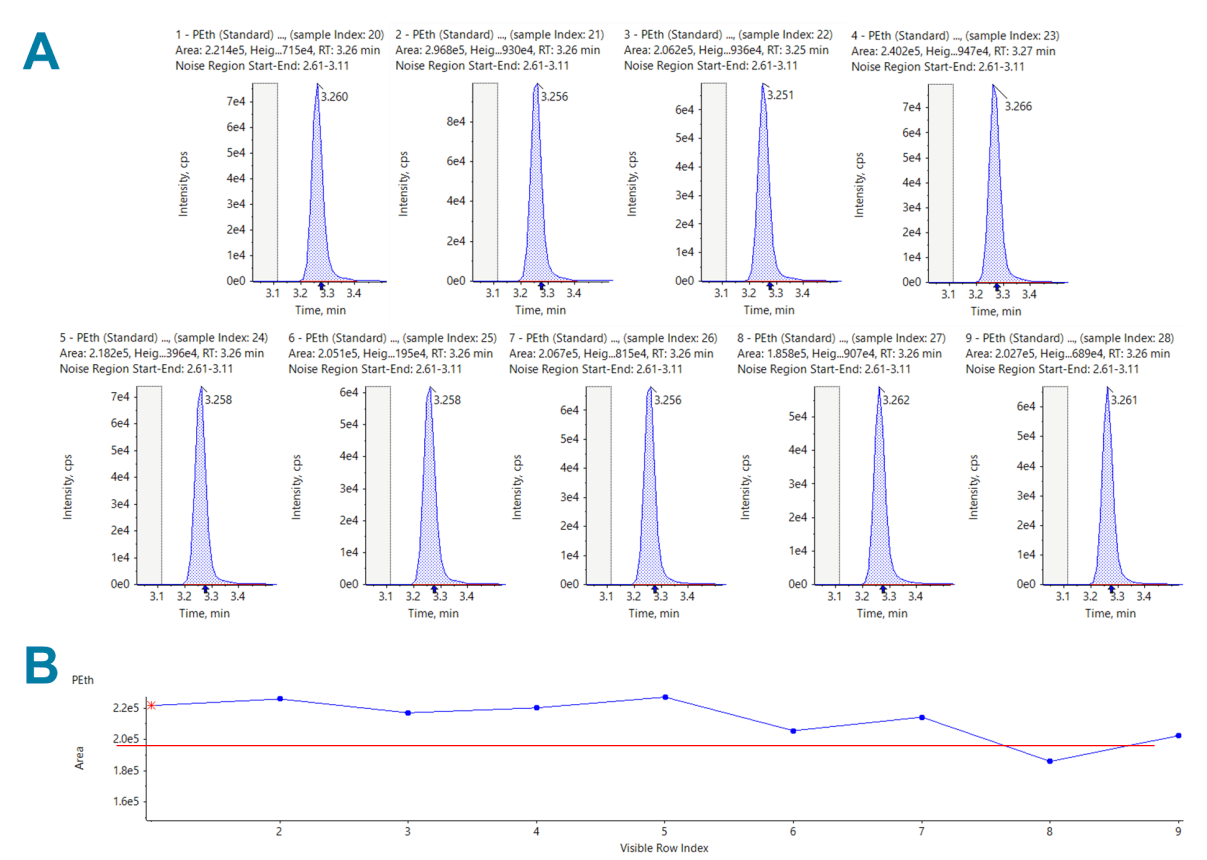 Click to enlarge
Click to enlarge